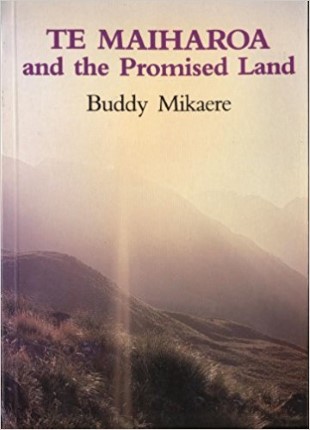
Te Maihaora and the Promised Land by Buddy Mikaere (1988)

Te Maiharoa and the Promised Land explores the impact that the loss of land had on the people of Te Waipounamu through retelling the story of the prophet Hipa Te Maiharoa, who led a heke of his people from Arowhenua on the coast to the upper Waitaki, the promised land.
Publication details
Mikaere, B. Te Maiharoa and the Promised Land. Auckland: Heinemann, 1988.
About the book
In 1877 the prophet Hipa Te Maiharoa led a heke from Arowhenua into the high country. After decades of land loss and unease at settler society’s influence on tikanga, Te Maiharoa looked to the mountains to land not included in Kemp’s Deed. When parliamentary petitions and legal challenges failed, Te Maiharoa, senior chief Rawiri Te Maire, and more than 100 followers decided to reoccupy the land themselves. The aim was non-violent direct action. In the winter of 1877 they crossed the Waitaki, then travelled west in search of their promised land. Moving slowly over frozen ground, they travelled under old tapu, and drew new inspiration from the biblical story of the Israelites and settled at Te Ao Mārama in the upper Waitaki. Te Maiharoa and his followers spent two years in the small village they’d founded: cultivating and harvesting kai, teaching and learning tikanga in the whare rūnunga, and rekindling ahi kā across the high country. Wealthy, influential sheep barons and their shepherds were hostile and following intense political pressure, the government assembled the armed constabulary and delivered an ultimatum.
Te Maiharoa is said to have called out “I do not want action which sheds blood,” and the decision was made to leave their settlement of Te Ao Mārama in peace, settling anew in Korotuaheka.
Buddy Mikaere (Ngāti Pukenga, Ngai Te Rangi) has written a fascinating and little-known history of a Te Wai Pounamu Prophet and leader whose attempts to protect land interests and develop a safe community for his people were viewed by Pakeha settlers and ultimately the Government with suspicion and alarm.
Further information
- Out of print
This publication is part of the series Te Takarangi: Celebrating Māori publications - a sample list of 150 non-fiction books produced by a partnership between Royal Society Te Apārangi and Ngā Pae o te Māramatanga.
